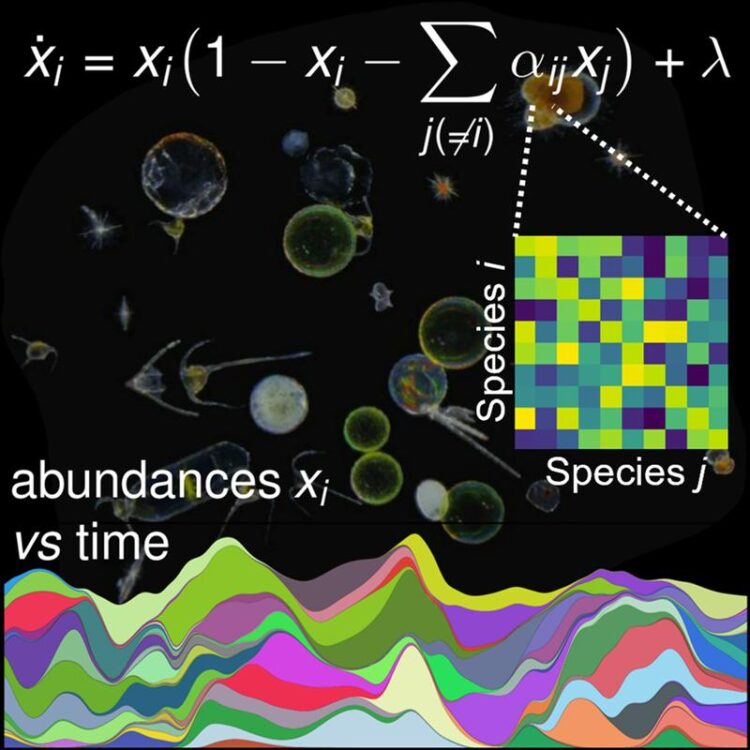New Insights into the Dynamics of Microbial Communities

Dynamical equations for strongly interacting species capture turnover of rare and abundant species, as seen in marine plankton protists.
© Emil Mallmin, MPI EvolBio
Researchers at the Max Planck Institute for Evolutionary Biology in Plön, within the Department of Theoretical Biology, characterized a recently discovered dynamical regime of microbial communities and used it to explain empirical patterns of marine plankton. There, strong and diverse interactions, combined with weak dispersal, fuel a continuous turnover of the small set of very abundant species, such that success is ephemeral and every species is equivalent in alternating between rarity and dominance.
Scientists at the Research Group for Dynamics of Microbial Collective focused on understanding the ecological mechanisms responsible for the observed outstanding diversity of microbial life forms. A significant hypothesis under discussion is that complex interactions between different taxa substantially influence the composition of microbial communities. However, strong competition is typically associated with the exclusion of all but a handful of species, clearly delineating ‘winners’ and ‘losers’ in the struggle for survival.
By modelling community dynamics by Lotka-Volterra equations with disordered, mostly competitive, interactions, the researchers found that whenever ‘losers’ are prevented to go extinct and allowed to linger around as rare, the dominant community eventually ends up being subverted. ‘Winner’ species then become rare, and a subset of formerly rare species have a drastic – though ephemeral, again – increase in abundance.
A notable discovery of the study is that which species dominates at what moment turns out to be intrinsically unpredictable and species are to a large degree dynamically equivalent. However, even the smallest differences between species affects the probability that they boom, which biases some species to be more often dominant or rare compared to others.
The researchers showed that the essential features of such chaotic dynamic are captured by a much simpler, single-species model, where a representative ‘focal’ species sees the fluctuations of the rest of the community as a noise, whose correlation reflects the time scale of the turnover. This model moreover produces a power-law decay of species abundance, a pattern that is ubiquitous in marine plankton communities.
The insights from this study have not only shed light on a process able to maintain high levels of species diversity, but also opened up potential applications in the analysis of time-resolved environmental recordings, providing significant impetus for future research.
The effect of interaction strength and heterogeneity on community dynamics and diversity, moreover, inspired the production of an original artistic creation combining science with animation, dance and music. The performance was awarded the prize of the public at the ARTEX Festival, held at the Institute of Complex System of Paris (https://iscpif.fr/artex23-prix/), highlighting the potential of mathematical models in public outreach.
Wissenschaftliche Ansprechpartner:
Dr. Emil Mallmin
Department for Theoretical Biology
Max Planck Institute for Evolutionary Biology
Originalpublikation:
https://doi.org/10.1073/pnas.231282212
https://www.evolbio.mpg.de/3737221/news_publication_21647959_transferred?c=5697
Media Contact
All latest news from the category: Life Sciences and Chemistry
Articles and reports from the Life Sciences and chemistry area deal with applied and basic research into modern biology, chemistry and human medicine.
Valuable information can be found on a range of life sciences fields including bacteriology, biochemistry, bionics, bioinformatics, biophysics, biotechnology, genetics, geobotany, human biology, marine biology, microbiology, molecular biology, cellular biology, zoology, bioinorganic chemistry, microchemistry and environmental chemistry.
Newest articles

Innovative 3D printed scaffolds offer new hope for bone healing
Researchers at the Institute for Bioengineering of Catalonia have developed novel 3D printed PLA-CaP scaffolds that promote blood vessel formation, ensuring better healing and regeneration of bone tissue. Bone is…

The surprising role of gut infection in Alzheimer’s disease
ASU- and Banner Alzheimer’s Institute-led study implicates link between a common virus and the disease, which travels from the gut to the brain and may be a target for antiviral…

Molecular gardening: New enzymes discovered for protein modification pruning
How deubiquitinases USP53 and USP54 cleave long polyubiquitin chains and how the former is linked to liver disease in children. Deubiquitinases (DUBs) are enzymes used by cells to trim protein…



